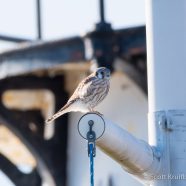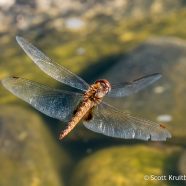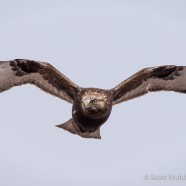Female American Kestrel
This has been one great late fall stretch for raptors for me. Not coincidentally, it has also been a poor stretch for passerines during my survey work, with very little of note apart from common and expected species in low numbers. Snowy Owls, Northern Harriers, Merlins, Peregrine Falcons, Red-tailed, Sharp-shinned, and Cooper’s Hawks have all been providing some great looks or photos. The unfortunately uncommon American Kestrel has even cooperated with this female being seen semi-regularly at Stratford Point. Her she is perched on the flagpole at the lighthouse before zipping off. I...
Read MoreSpot-winged Glider
I finally captured a Spot-winged Glider (Pantala hymenaea) on the wing, and in this case it while the dragonfly was ovipositing – laying eggs in this pool. You can clearly see the basal spots on the inside of the hindwings along with some wear. Flying around the world must get a bit tiring… Scott Kruitbosch Conservation & Outreach Coordinator
Read MoreFemale Blue Dasher Ovipositing
How cool does this hovering aircraft look? This female Blue Dasher (Pachydiplax longipennis) is ovipositing, laying eggs, into aquatic vegetation in a pond as photographed last week. As you can see they are quite skilled at keeping their head still while their wings are whipping and the abdomen is being pressed into the water.
Read MoreGlossy Ibis
This is not a bird you expect to fly by low over your head, nor one you are ready to turn up and shoot…but here is the Glossy Ibis (Plegadis falcinellus), a wader of the Atlantic and Gulf Coasts. The species is actually present on six continents, and because it is a long-legged wading bird found in our coastal marshes it is one of the many species we tally in the Audubon Alliance for Coastal Waterbirds. Protecting their habitat, tracking their populations, and studying where they are and when all helps us learn more now and utilize better conservation management practices later. Scott...
Read MoreRough-legged Hawk
This Rough-legged Hawk put on a brief but thrilling show for me today, facing into the wind to help it hover while scanning the land below for any small mammal prey. The wind was particularly strong thanks to the major storm currently impacting the Northeast region. Whichever one of the hawk’s eyes that was being battered by the wind the most was often covered by its nictitating membrane. This third eyelid is almost like wearing a pair of sunglasses for the raptor in that it can still see while the eye is more protected than it would be otherwise. It was also keeping the eye moist with...
Read More








